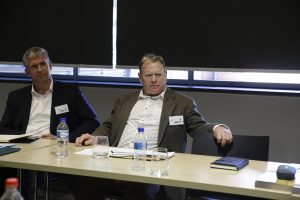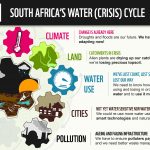
Paul Makube (centre), senior agricultural economist at First National Bank South Africa
The agronomists had spoken (see previous blog). The financiers were next …
Paul Makube described how banks look at the farmer’s handling of natural resources. Soil is certainly a part of this, and critical from both a profitability and risk perspective. Farmers may face uncertainties like seasonal changes and volatility in prices of both inputs and outputs, but soil health is the top factor as it determines the future sustainability of the farming business. Using benchmark- and data from their own lands, one can have discussions with farmers about the space they are in.

John Hudson (right), National Agriculture Head at Nedbank Business Banking
John Hudson began with a reference to agriculture’s contribution to global carbon emissions and the Sustainable Development Goals (SDGs). The focus is thus on more responsible food production, food safety and traceability, clean energy, water efficiency – and soil health.
Soils underpin value chains by supporting crop productivity, biodiversity and livelihoods. And they play a crucial role in two of the top business risks: water and climate change. If we are to have sustainable businesses, economies and societies, they will be built on healthy soils. We have to get soils right!
In the pursuit of financial sustainability many farmers head towards conservation agriculture: soil health is very much a part of that. The increasing availability of climate-smart finance will assist in the transition from conventional agriculture to conservation agriculture. Previously, financiers would look at the farming business’ past patterns, the economic track record. Increasingly we will look beyond this, at farming practices, the organic content of soil, the use of mulching and farming practices which reduce the water required by up to 90%. We need to reward good farming practice.
In time, carbon budgets and carbon taxes in South Africa will further incentivise climate-smart agriculture.

Zhann Meyer, Head of Agricultural Commodities Business, Nedbank
Zhann Meyer picked up where his Nedbank colleague had left off. Complimenting South African farmers for the way they have picked up on precision farming, no-till and other innovations, he said the rest of the world takes note of how our farmers do it!
He referenced the UN’s SDGs as the benchmark and measurement matrix to which Nedbank had aligned itself. Up until now, bankers judged farm productivity by looking at long-term average yields. But perhaps they should use the tools now becoming available to measure what farmers do to conserve the soil – to look at long-term sustainable average yield. In the light of soil being a finite and scarce resource, it would be “apt” for financial institutions to explore ways in which finance could contribute towards preserving the soil. Holding up colourful, simple material, Meyer also speculated on how to reach the millions of subsistence farmers with information on looking after soils.

Kevin Hoff, Partner and Head of Financial Services, BDO
Kevin Hoff agreed that sustainable soil solutions could unlock financing and insurance prospects for farmers, but coupled this with wider financial risk management and awareness of hedging strategies to manage input/output price risks.

A discussion followed around points raised by the presentations. Was there a difference between the production value of the land vs the value of the land itself? How to achieve a longer-term engagement on encouraging the movement from conventional agriculture to conservation agriculture.
In addition to incentives like easier terms for further loans to soil health-compliant farmers, market pressure could also be used by big buyers to encourage any who were not paying sufficient attention to their soils. This could strengthen the use of good agricultural practice tools like the SUSFARMS system, a resource for sugarcane farmers designed by the South African Sugarcane Research Institute (Sasri) with highly useful checklists incorporating management, legal, financial and environmental guidelines for farmers.
There was agreement on the need to make information as simple as possible. The Omnia Soil Health Prism was held up again as an example. Soil could be likened to a machine or something with many moving parts. Tools which integrated data were needed to resolve issues and help decision-making.
The agronomists and financiers were given the opportunity to sum up their ideas after which Jan Vermaak brought proceedings to a close.
Relevant pages in AgribookDigital include “Conservation agriculture“, “Precision farming“, “Risk management” and the pages listed at the end of the previous blog.







